Abstract
Exact equations are obtained to describe the propagation of the cladding modes in twisted optical fibers. Numerical solutions of these equations are found, which demonstrate that the paraxial approximation is not accurate for the cladding modes. Propagation constants and field distributions for the eigen circularly polarized modes are calculated for the coreless and standard fibers under twist. The cladding modes are affected by twisting much stronger than the core mode, and their field profiles are distorted. The exact modes have a mismatch between the radial and azimuthal components of the fields and cannot be combined to form the LP modes. Twisting may result in a change of sensitivity of the fiber to the external medium, which can be important for sensing applications.
1. Introduction
Fiber twisting is a simple and versatile method of modification of fiber structure, which provides additional opportunities for controlling light propagation. Twisted fibers can be used in different applications of fiber optics—in particular, in sensors of current [1], torsion [2,3], temperature [4] in fiber lasers [5], circular polarizers, couplers [6], optical vortices generators [7,8,9], and converters [10]. The optical effects of twisting are also of great fundamental interest [11], especially in relation with orbital angular momentum studies and vortex beams [12].
Helical structures are formed when the fiber under twist has some inner asymmetry. Helical core fibers are obtained by twisting a step-index fiber with an offset [13], elliptical, or square step-index core [6,14]. Such helical structures couple the core and cladding modes and behave like long-period fiber gratings. A lot of interest is attracted to twisting microstructured optical fibers [11,15,16,17,18,19] with applications in sensors, polarization and dispersion controllers, and spin-orbit couplers [20].
It is well known that the plane of polarization of the core mode in a twisted fiber rotates in the direction of the twist [21,22] with the rate proportional to the photoelastic coefficients of silica. Twisting can induce tuning of resonant wavelengths of long-period fiber gratings. The wavelength shift depends on the method of grating fabrication and the type of fiber. In microbend long-period fiber gratings, the cladding mode resonances are split for strong twists [23].
For the cladding fiber modes, the first-order paraxial approximation was previously used to obtain the distributions of the electric and magnetic fields [24]. It was demonstrated that the cladding modes propagating in a twisted fiber rotate along the direction of the twist at the same rate as the core mode, independently of the azimuthal and radial mode numbers. For strong twists, the mode degeneracy is removed, and the resonances of twisted long-period fiber gratings are split due to the difference between the longitudinal components of the electric field of cladding modes.
Until now, the limit twist rate when the paraxial approximation is still applicable for the cladding modes was not known. Therefore, a more accurate solution is needed when strong twist is applied to the optical fiber. A fully vectorial numerical method based on the transformation optics formalism is used in [14] for twisted fibers with an elliptical core to analyze the effect of resonant coupling between the core and cladding modes. For the standard fiber, the twist does not change the form of the fiber but induces anisotropy in silica. This anisotropy modifies propagation constants of the cladding modes and may also induce distortion of their field profiles, which has not been studied previously.
In this paper, we obtain exact equations describing propagation of eigen modes in twisted optical fibers and find the numerical solutions of these equations. We analyze when the approximate solutions that were used previously become invalid. We calculate propagation constants and field distributions for the eigen modes of the twisted fibers as functions of the twist rate. We discuss effects other than polarization rotation that can be observed for the cladding modes of twisted fibers.
2. Equations for Modes in Twisted Fiber
In order to obtain exact solutions for the modes of a twisted fiber, we consider harmonic fields in the form E, H ~ exp(iωt). Then, Maxwell’s equations are expressed as
where is the wavenumber in vacuum. The dielectric tensor consists of the diagonal part describing the refractive index profile in the fiber cross-section and the off-diagonal part describing the anisotropic perturbation induced by the shear strain, which increases proportionally to the radius r:
where is the unit tensor, , , and are the photoelastic constants, and is the twist rate.
We assume that the electromagnetic wave propagates along the z axis and the fields can be presented as E, H ~ exp[i(νφ − −βz)], where is the propagation constant, and is the azimuthal mode number, which defines the azimuthal mode profile. In the paraxial approximation, for the right circular polarization, and for the left circular polarization. The linear polarized mode can be obtained by summation of two modes with opposite circular polarizations.
Substituting the fields and the dielectric tensor into Equation (1), we can exclude the radial fields and write the following equations:
where , . The system of four Equations (3) has four variables of electric and magnetic field components and one unknown parameter, which is the propagation constant . The other two radial field components can be found from the following relations:
We introduce the parameter of anisotropy that describes the maximum magnitude of the off-diagonal component, which is attained at the outer cladding radius:
Then,
For the parameters of the standard silica fiber, the dielectric permittivity , cladding radius , photelastic constants , and, hence, . The parameter can reach magnitudes up to 0.015 for twists 1.7 rad/mm that silica fibers can withstand. Larger values of the parameter can be achieved for plastic fibers withstanding much higher deformations.
We solved system of differential Equations (3) numerically with Matlab’s fifth-order method of solving boundary value problem. The boundary value problem being solved included an unknown parameter . The solver calculates the values of the unknown parameter starting from its initial guess. In order to obtain a particular mode, initial solution guess should be close to the desired mode field profiles for and and the unknown parameter should be close to the corresponding propagation constant .
3. Numerical Solution for Propagation Constants
First, we analyze the case of twisting a simple circular waveguide such as coreless fiber. Figure 1 demonstrates the result of numerical solution for a coreless fiber with μm, , and wavelength nm. The effective refractive index is shown as a function of the anisotropy parameter , which is proportional to the twist rate.
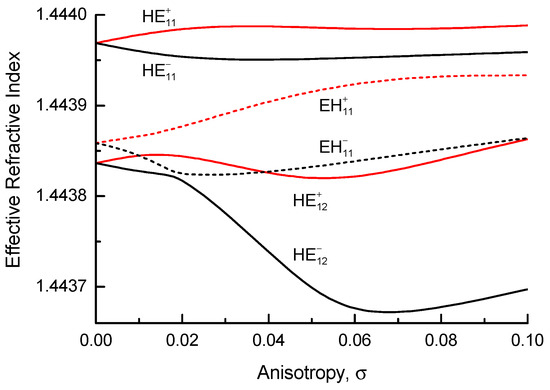
Figure 1.
Effective refractive indices of the cladding modes HE1ν and EH1ν as functions of the anisotropy parameter for the coreless fiber.
For small magnitudes of the twist rate (), the dependences for all modes are close to linear functions with positive or negative slopes having the same absolute magnitude. This is described by the known relation
or
where is the propagation constant in the untwisted fiber and for the right and left circularly polarized modes (indicated by the plus and minus signs in the figure). In this case, the right and left circularly polarized modes have quite similar profiles and can be summed to obtain the linear polarized modes, whose polarization rotates with the speed in the direction of twisting.
In Figure 2, a similar dependence is presented for the standard fiber having a core with μm, , and the same parameters of the cladding and wavelength. The modes with the highest effective refractive indices here are the circularly polarized core modes. They have purely linear dependences on the twist rate within the limits presented in the figure ().
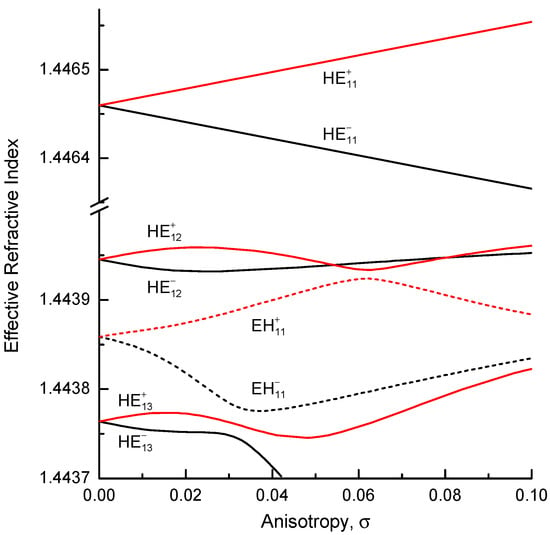
Figure 2.
Effective refractive indices of the core and cladding modes HE1ν and EH1ν as functions of the anisotropy parameter for the standard fiber.
For twists with , the curves for cladding modes do not follow straight lines for both the types of fibers. Such a magnitude of corresponds to twist rates above 5 rad/cm. The curves for the right and left HE modes converge with increasing twist, while the curves for the EH modes first diverge and then converge for twist rates with σ > 0.06. There are several intersections between the curves for the HE− and EH+ modes, which are points of mode degeneracy.
In Figure 2, there are two intersections between the curves for the orthogonal right and left modes, which is impossible in a weakly twisted fiber. In these points of degeneracy, the combination of two modes is not changing its polarization during propagation along the fiber. However, this combination is no longer a linear polarized mode, because the fields of the right and left circular modes do not match. For the range of twists , there is inversion of propagation constants where the right circularly polarized mode has smaller propagation constant than the left one.
For magnitudes of anisotropy , the behavior of the effective refractive indices of cladding modes becomes quite irregular. However, intersections between the curves for modes of the same type and circular polarization but different radial mode numbers (for example, and ) are not possible.
4. Field Distributions of Modes in Twisted Fibers
We calculated the electric field profiles of various HE1ν and EH1ν cladding modes for the coreless and standard fibers. The components of the electric field for pristine fiber with no twist and twisted fiber with are depicted in Figure 3 as functions of radius. The radial component of the electric field is imaginary; therefore, is shown. The mode fields are normalized to the same energy flux along the z axis.

Figure 3.
Electric field profiles of HE11 cladding mode for coreless fibers, which are (a) pristine and (b) twisted with . The solid and dashed curves are for the right and left circularly polarized modes, respectively. The scale for Ez is increased by a factor of 10.
For the coreless fiber (Figure 3a,b), the HE11 modes have a cosine shape ( Bessel function) profile inside the cladding and exponentially decreasing in the outer space. and have opposite signs but almost the same absolute values. With increasing twist rate, the profiles of different components no longer coincide, which means that the linear polarized mode cannot be obtained by combining two circularly polarized modes. For the right circularly polarized mode, the azimuthal component is repelled from the cladding surface with strongest shear strain closer to the center. The radial component is, on the contrary, attracted closer to the cladding surface. For the left circularly polarized mode, the shifts of the profiles are inverse and somewhat weaker. It is interesting to note that the component changes its sign near the surface, while vanishes. Therefore, twisting may result in the modification of surface sensitivity of the fiber to the external medium, which can be important for sensing applications.
The EH11 modes (Figure 4) have electric field profiles with small amplitudes in the center of fiber without twist. The profiles change drastically in the twisted fiber: all components have different shapes with strong amplitudes in the center. Normally, the EH modes are weakly excited in fiber gratings due to their low field overlap with the core mode. We see here that, in a twisted fiber, the overlap may become large, since field amplitude is strong in the fiber center.
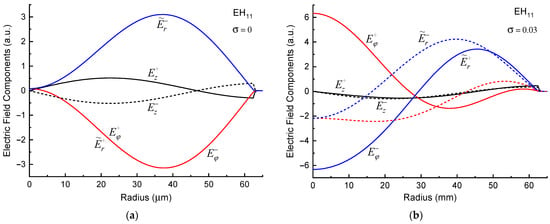
Figure 4.
Electric field profiles of EH11 cladding mode for coreless fibers, which are (a) pristine and (b) twisted with . The solid and dashed curves are for the right and left circularly polarized modes, respectively. The scale for Ez is increased by a factor of 10.
For the standard fiber with a core (Figure 5), the first cladding mode is HE21. Its field amplitude near the core radius is close to zero. Generally, the behavior of this mode with increasing twist is similar to the behavior of the HE11 modes in the coreless fiber. The field profiles are weakly modified in the core region of the fiber.
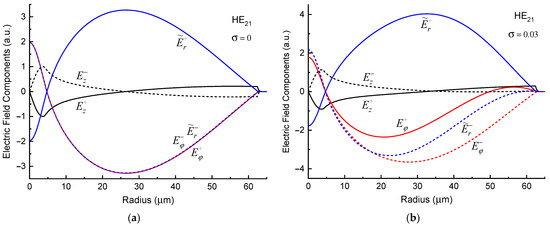
Figure 5.
Electric field profiles of HE12 cladding mode for standard fibers, which are (a) pristine and (b) twisted with . The solid and dashed curves are for the right and left circularly polarized modes, respectively. The scale for Ez is increased by a factor of 10.
In most cases, have low absolute values and opposite signs for the right and left circular polarizations. There are some changes in its profiles for the twisted fibers; however, its amplitude is small compared to the transverse field components. In the twisted fiber, the energy flux represented by the Poynting vector is directed along the fiber axis the same as in pristine fiber.
Figure 6 demonstrates the profiles of the Pointing vector amplitudes of the HE11 and HE12 right and left circularly polarized cladding modes for the coreless and standard fibers, which are untwisted and twisted with . From the modification of the HE modes, we may notice that the energy flux is shifted to the cladding surface for the right circularly polarized modes and from the cladding surface for the left circularly polarized modes. Thus, the shear strain at the cladding surface attracts the light wave like a region with higher refractive index for the right circularly polarized modes and with lower refractive index for the left circularly polarized modes, despite the fact that the diagonal component of the dielectric tensor is not changed. This effect may possibly be employed to form a waveguide by twisting a homogeneous material.
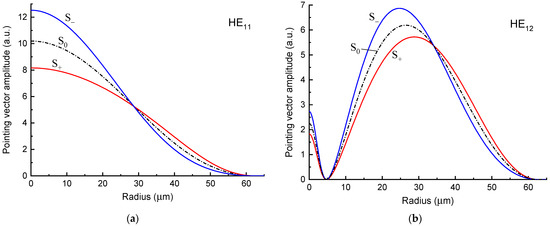
Figure 6.
Profiles of the Pointing vector amplitudes of the HE11 and HE12 cladding modes for (a) coreless and (b) standard fibers, respectively, which are untwisted (dash-dotted curve, S0) and twisted with (solid curves). The red and blue curves are for the right and left circularly polarized modes (S+ and S−), respectively.
5. Discussion
In the case of a strongly twisted fiber, the anisotropy value of 0.015 becomes higher than the core-cladding index difference (0.0054). In fact, this is the essence of the effects that are observed. The twist-induced refractive index anisotropy changes guiding properties of the fiber. These twist-induced and core-cladding refractive index differences are independent values. The core-cladding index difference can be even smaller, and it is defined during fabrication, but the anisotropy value is determined by the twist rate. On the other hand, the anisotropy induced by twisting has indirect influence on propagation constant of the fiber modes due to the fact that it has only off-diagonal nonzero component, which couples with the longitudinal electric field. This field is weaker than the transverse field for low order fiber modes. Therefore, the contribution of the anisotropy induced by twisting is weaker than the contribution of the isotropic (diagonal) dielectric tensor components.
Polymer stretchable step-index optical fibers capable to reversibly withstand deformations up to 300% while guiding light have been demonstrated [25], which is two orders of magnitude higher than for silica fibers. However, there are no available data on photoelastic coefficients for these stretchable fibers. Providing practical examples of optical fibers for which the effective refractive index curves actually start converging could be interesting future experimental work.
An exact solution for cladding modes in twisted optical fibers means, in our case, that we solve equations whose derivation does not invoke simplifying assumptions. Although the solution of these equations is found numerically, its accuracy is not limited and can be arbitrarily high. The accuracy in the calculation of the propagation constant for each specific mode is achieved by specifying relative error tolerance in the Matlab function and the cut-off radius. The cut-off radius of the calculation is 67.5 um. This radius should be at least several wavelengths far from the cladding radius, so that the boundary condition of zero field amplitude is close to some very small magnitude of the real evanescent field dropping exponentially when moving out from the cladding radius. The relative error tolerance for the electric field in our numerical calculation is by default 0.1%. The corresponding accuracy in the calculation of propagation constants is about .
In this paper, we focused on the case of cladding modes corresponding to orbital angular number , which is most relevant for optical fiber applications, but it would be also interesting to study the cases of larger values of ν, which can be done in the future investigations.
6. Conclusions
In conclusion, we used Maxwell’s equation to obtain an exact system of equations describing electromagnetic fields in twisted fibers. We solved this system numerically and found solutions for the eigen cladding modes, which have circular polarizations. The cladding modes are affected by twisting much stronger than the core mode. We demonstrated that the paraxial approximation is not accurate enough for twists rate above 5 rad/cm. For twist rates above this value, the propagation constants of the circularly polarized cladding modes do not diverge in contrast to the core modes. The exact modes have a mismatch between the radial and azimuthal components of the fields and cannot be combined to form the LP modes. The right and left circularly polarized modes in a twisted fiber may be degenerate and have the same propagation constants. The shear strain at the cladding surface of the twisted fiber attracts one circularly polarized mode and repulses the other orthogonally polarized mode. Twisting may result in a change of the surface fields and modification of sensitivity of the fiber to the external medium, which can be important for sensing applications.
Funding
This research was funded in part by UK EPSRC under grant EP/W025108/1.
Data Availability Statement
Not available.
Conflicts of Interest
The authors declare no conflict of interest.
References
- Gubin, V.; Isaev, V.; Morshnev, S.; Sazonov, A.; Starostin, N.; Chamorovskii, Y.; Usov, A. Use of spun optical fibres in current sensors. Quantum Electron. 2006, 36, 287–291. [Google Scholar] [CrossRef]
- Fernandes, L.A.; Grenier, J.R.; Aitchison, J.S.; Herman, P.R. Fiber optic stress-independent helical torsion sensor. Opt. Lett. 2015, 40, 657–660. [Google Scholar] [CrossRef]
- Shen, F.; Shu, X.; Zhou, K.; Jiang, H.; Xia, H.; Xie, K.; Zhang, L. Compact vector twist sensor using a small period long period fiber grating inscribed with femtosecond laser. Chin. Opt. Lett. 2021, 19, 090601. [Google Scholar] [CrossRef]
- Zhu, C.; Piao, Q.; Zhao, Y.; Li, H. Ultra-broad edge filter based on a periodically twisted graded-index fiber and its application to a power-interrogated temperature sensor. Opt. Express 2022, 30, 34776–34786. [Google Scholar] [CrossRef] [PubMed]
- Wang, P.; Cooper, L.J.; Sahu, J.K.; Clarkson, W.A. Efficient single-mode operation of a cladding-pumped ytterbium-doped helical-core fiber laser. Opt. Lett. 2006, 31, 226–228. [Google Scholar] [CrossRef]
- Kopp, V.I.; Park, J.; Wlodawski, M.; Singer, J.; Neugroschl, D.; Genack, A.Z. Chiral fibers: Microformed optical waveguides for polarization control, sensing, coupling, amplification, and switching. J. Light. Technol. 2014, 32, 605–613. [Google Scholar] [CrossRef]
- Alexeyev, C.N.; Alexeyev, A.N.; Lapin, B.P.; Milione, G.; Yavorsky, M.A. Spin-orbit-interaction-induced generation of optical vortices in multihelicoidal fibers. Phys. Rev. A 2013, 88, 063814. [Google Scholar] [CrossRef]
- Chang, W.; Feng, M.; Wang, P.; Wang, Z.; Liu, Y.-G. High-efficiency broadband third-order OAM mode converter based on a multi-period preset-twist long-period fiber grating. Opt. Express 2022, 30, 47048–47058. [Google Scholar] [CrossRef] [PubMed]
- Liu, S.; Zhou, M.; Shao, L.; Zhang, Z.; Bai, Z.; Wang, Y. Torsion-tunable OAM mode generator based on oxyhydrogen-flame fabricated helical long-period fiber grating. Opt. Express 2022, 30, 21085–21093. [Google Scholar] [CrossRef]
- Chang, W.; Feng, M.; Mao, B.; Wang, P.; Wang, Z.; Liu, Y.-G. All-fiber fourth-order OAM mode generation employing a long period fiber grating written by preset twist. J. Light. Technol. 2022, 40, 4804–4811. [Google Scholar] [CrossRef]
- Ramin, B.; Wong, G.K.L.; Frosz, M.H.; Xi, X.M.; Russell, P.S.J. Twist-induced guidance in coreless photonic crystal fiber: A helical channel for light. Sci. Adv. 2016, 2, e1601421. [Google Scholar] [CrossRef]
- Wu, Y.; Wen, J.; Zhang, M.; Cao, Y.; Chen, W.; Zhang, X.; Yusufu, T.; Pang, F.; Wang, T. Low-loss and helical-phase-dependent selective excitation of high-order orbital angular momentum modes in a twisted ring-core fiber. Opt. Lett. 2022, 47, 4016–4019. [Google Scholar] [CrossRef]
- Ivanov, O.V. Fabrication of long-period fiber gratings by twisting a standard single-mode fiber. Opt. Lett. 2005, 30, 3290–3292. [Google Scholar] [CrossRef]
- Napiorkowski, M.; Urbanczyk, W. Rigorous simulations of coupling between core and cladding modes in a double-helix fiber. Opt. Lett. 2015, 40, 3324–3327. [Google Scholar] [CrossRef]
- Russell, P.S.J.; Beravat, R.; Wong, G.K.L. Helically twisted photonic crystal fibres. Phil. Trans. R. Soc. A 2017, 375, 20150440. [Google Scholar] [CrossRef]
- Edavalath, N.N.; Günendi, M.C.; Beravat, R.; Wong, G.K.L.; Frosz, M.H.; Ménard, J.-M.; Russell, P.S.J. Higher-order mode suppression in twisted single-ring hollow-core photonic crystal fibers. Opt. Lett. 2017, 42, 2074–2077. [Google Scholar] [CrossRef]
- Roth, P.; Chen, Y.; Günendi, M.C.; Beravat, R.; Edavalath, N.N.; Frosz, M.H.; Ahmed, G.; Wong, G.K.L.; Russell, P.S.J. Strong circular dichroism for the HE11 mode in twisted single-ring hollow-core photonic crystal fiber. Optica 2018, 5, 1315–1321. [Google Scholar] [CrossRef]
- Napiorkowski, M.; Urbanczyk, W. Scaling effects in resonant coupling phenomena between fundamental and cladding modes in twisted microstructured optical fibers. Opt. Express 2018, 26, 12131–12143. [Google Scholar] [CrossRef] [PubMed]
- Zhu, Y.; Li, W.; Gao, F.; Xu, X.; Song, N. Hybrid photonic bandgap effect in twisted hollow-core photonic bandgap fibers. Opt. Lett. 2022, 47, 6161–6164. [Google Scholar] [CrossRef]
- Xi, X.M.; Wong, G.K.L.; Frosz, M.H.; Babic, F.; Ahmed, G.; Jiang, X.; Euser, T.G.; Russell, P.S.J. Orbital-angular-momentum-preserving helical Bloch modes in twisted photonic crystal fiber. Optica 2014, 1, 165–169. [Google Scholar] [CrossRef]
- Ulrich, R.; Simon, A. Polarization optics of twisted single-mode fibers. Appl. Opt. 1979, 18, 2241–2251. [Google Scholar] [CrossRef] [PubMed]
- Smith, A.M. Birefringence induced by bends and twists in single-mode optical fiber. Appl. Opt. 1980, 19, 2606–2611. [Google Scholar] [CrossRef]
- Ivanov, O.V. Wavelength shift and split of cladding mode resonances in microbend long-period fiber gratings under torsion. Opt. Commun. 2004, 232, 159–166. [Google Scholar] [CrossRef]
- Ivanov, O.V. Propagation and coupling of hybrid modes in twisted fibers. J. Opt. Soc. Am. A 2005, 22, 716–723. [Google Scholar] [CrossRef] [PubMed]
- Leber, A.; Cholst, B.; Sandt, J.; Vogel, N.; Kolle, M. Stretchable thermoplastic elastomer optical fibers for sensing of extreme deformations. Adv. Funct. Mater. 2019, 29, 1802629. [Google Scholar] [CrossRef]
Disclaimer/Publisher’s Note: The statements, opinions and data contained in all publications are solely those of the individual author(s) and contributor(s) and not of MDPI and/or the editor(s). MDPI and/or the editor(s) disclaim responsibility for any injury to people or property resulting from any ideas, methods, instructions or products referred to in the content. |
© 2023 by the author. Licensee MDPI, Basel, Switzerland. This article is an open access article distributed under the terms and conditions of the Creative Commons Attribution (CC BY) license (https://creativecommons.org/licenses/by/4.0/).